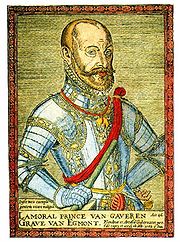
Egmont (Beethoven)
Encyclopedia

Ludwig van Beethoven
Ludwig van Beethoven was a German composer and pianist. A crucial figure in the transition between the Classical and Romantic eras in Western art music, he remains one of the most famous and influential composers of all time.Born in Bonn, then the capital of the Electorate of Cologne and part of...
, is a set of incidental music
Incidental music
Incidental music is music in a play, television program, radio program, video game, film or some other form not primarily musical. The term is less frequently applied to film music, with such music being referred to instead as the "film score" or "soundtrack"....
pieces for the 1787 play of the same name
Egmont (play)
Egmont is a play by Johann Wolfgang von Goethe, which he completed in 1788. Its dramaturgical structure, like that of his earlier 'Storm and Stress' play Götz von Berlichingen , is heavily influenced by Shakespearean tragedy; in contrast, however, to the earlier work, the portrait in Egmont of the...
by Johann Wolfgang von Goethe
Johann Wolfgang von Goethe
Johann Wolfgang von Goethe was a German writer, pictorial artist, biologist, theoretical physicist, and polymath. He is considered the supreme genius of modern German literature. His works span the fields of poetry, drama, prose, philosophy, and science. His Faust has been called the greatest long...
. It consists of an overture
Overture
Overture in music is the term originally applied to the instrumental introduction to an opera...
followed by a sequence of nine additional pieces for soprano
Soprano
A soprano is a voice type with a vocal range from approximately middle C to "high A" in choral music, or to "soprano C" or higher in operatic music. In four-part chorale style harmony, the soprano takes the highest part, which usually encompasses the melody...
, male narrator
Narrator
A narrator is, within any story , the fictional or non-fictional, personal or impersonal entity who tells the story to the audience. When the narrator is also a character within the story, he or she is sometimes known as the viewpoint character. The narrator is one of three entities responsible for...
and full symphony orchestra. Beethoven wrote it between October 1809 and June 1810, and it was premiered on 15 June 1810.
The subject of the music and dramatic narrative is the life and heroism of a 16th-century Flemish
Flemish
Flemish can refer to anything related to Flanders, and may refer directly to the following articles:*Flemish, an informal, though linguistically incorrect, name of any kind of the Dutch language as spoken in Belgium....
nobleman, the Count of Egmont
Lamoral, Count of Egmont
Lamoral, Count of Egmont, Prince of Gavere was a general and statesman in the Habsburg Netherlands just before the start of the Eighty Years' War, whose execution helped spark the national uprising that eventually led to the independence of the Netherlands.The Count of Egmont headed one of the...
. It was composed during the period of the Napoleonic Wars
Napoleonic Wars
The Napoleonic Wars were a series of wars declared against Napoleon's French Empire by opposing coalitions that ran from 1803 to 1815. As a continuation of the wars sparked by the French Revolution of 1789, they revolutionised European armies and played out on an unprecedented scale, mainly due to...
, at a time when the French Empire
First French Empire
The First French Empire , also known as the Greater French Empire or Napoleonic Empire, was the empire of Napoleon I of France...
had extended its domination over most of Europe. Beethoven had famously expressed his great outrage over Napoleon Bonaparte's
Napoleon I
Napoleon Bonaparte was a French military and political leader during the latter stages of the French Revolution.As Napoleon I, he was Emperor of the French from 1804 to 1815...
decision to crown himself Emperor in 1804, furiously scratching out his name in the dedication of the Eroica Symphony
Symphony No. 3 (Beethoven)
Ludwig van Beethoven's Symphony No. 3 in E flat major , also known as the Eroica , is a landmark musical work marking the full arrival of the composer's "middle-period," a series of unprecedented large scale works of emotional depth and structural rigor.The symphony is widely regarded as a mature...
. In the music for Egmont, Beethoven expressed his own political concerns through the exaltation of the heroic sacrifice of a man condemned to death for having taken a valiant stand against oppression. The Overture later became an unofficial anthem of the 1956 Hungarian revolution
1956 Hungarian Revolution
The Hungarian Revolution or Uprising of 1956 was a spontaneous nationwide revolt against the government of the People's Republic of Hungary and its Soviet-imposed policies, lasting from 23 October until 10 November 1956....
.
The music was greeted with eulogistic praise, in particular by E.T.A. Hoffmann for its poetry, and Goethe himself declared that Beethoven had expressed his intentions with "a remarkable genius".
The overture, powerful and expressive, is one of the last works of his middle period; it has become as famous a composition as the Coriolan Overture, and is in a similar style to the Fifth Symphony
Symphony No. 5 (Beethoven)
The Symphony No. 5 in C minor, Op. 67, was written by Ludwig van Beethoven in 1804–08. This symphony is one of the most popular and best-known compositions in all of classical music, and one of the most often played symphonies. It comprises four movements: an opening sonata, an andante, and a fast...
, which he had completed two years earlier.
Outline of sections
The incidental music includes the following sections, among which the overture, the lieder Die Trommel gerühret, Freudvoll und Leidvoll and the mort de Klärchen are particularly well-known:- Overture: Sostenuto, ma non troppo - Allegro
- Lied: "Die Trommel gerühret"
- Entracte: Andante
- Entracte: Larghetto
- Lied: "Freudvoll und Leidvoll"
- Entracte: Allegro - Marcia
- Entracte: Poco sostenuto e risoluto
- Mort de Klärchen
- Melodram: "Süßer Schlaf"
- Siegessymphonie (symphony of victory): Allegro con brio

